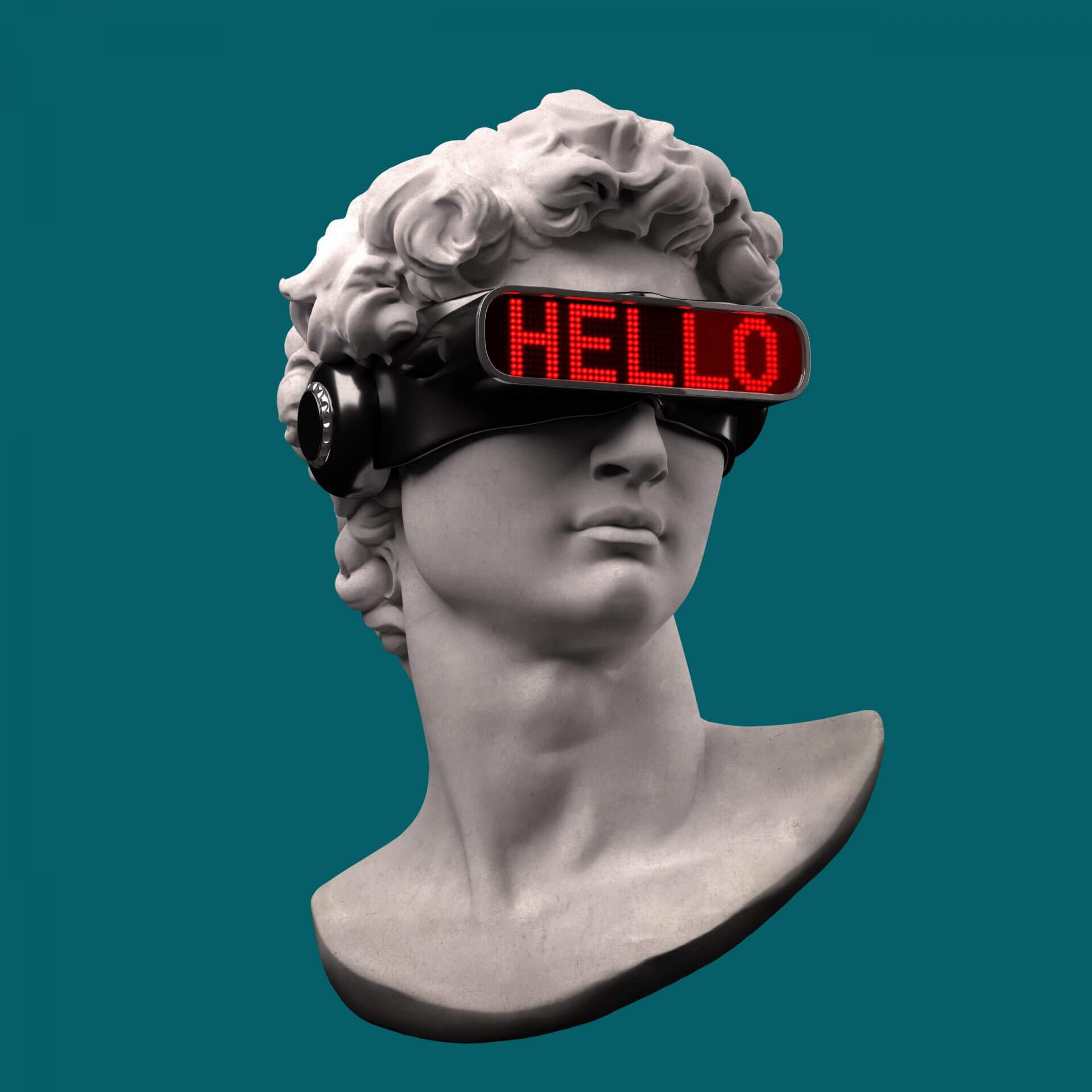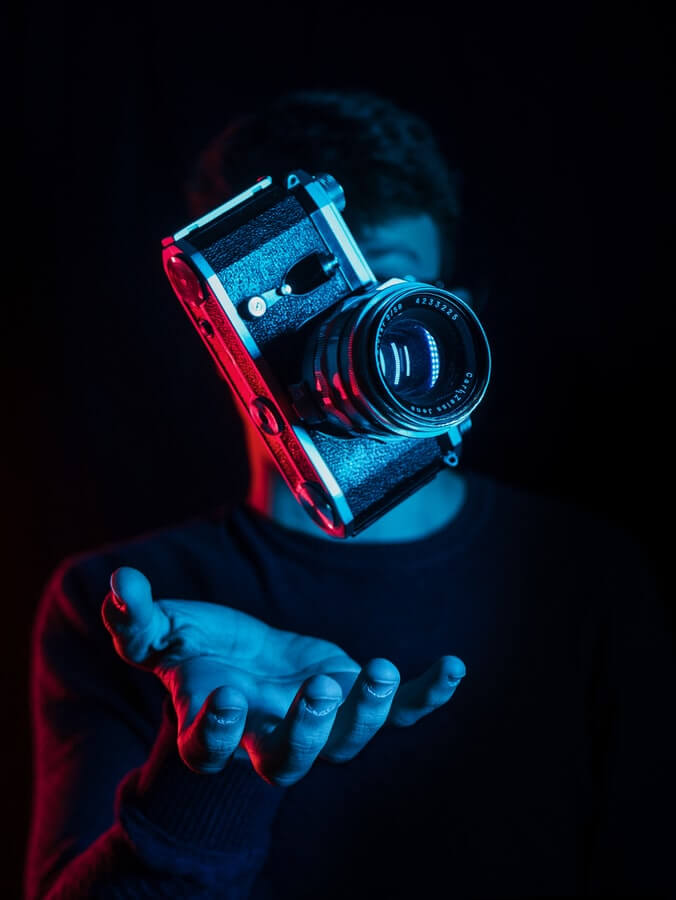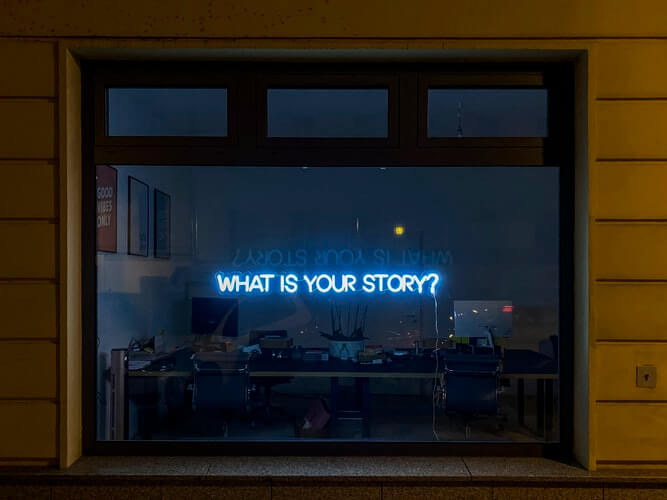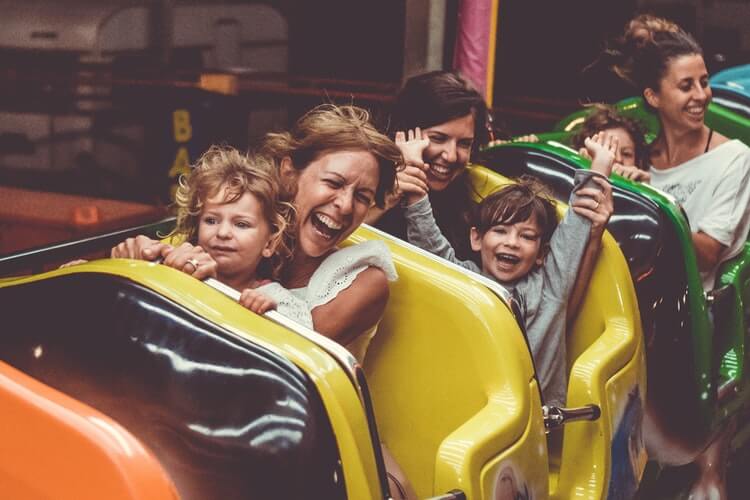Want a heads up when a new story drops? Subscribe here.
Virtual storytelling is a relatively new concept but the idea has been around for a long time. Spanning from 30,000 to 10,000 BCE, the Old Stone or Paleolithic Age produced the first creative accomplishments in human history. Prehistoric humans carved, engraved, drew, and painted to record stories and communicate beliefs and experiences. Art has evolved tremendously since the dawn of human creativity, enabling humans to share the richness of their inner experiences.
Today storytelling is used in areas like entertainment, journalism, and business communications. It is also associated with a multitude of visual arts mediums, including animation, photography, video production and filmmaking, virtual reality, B2B events and conferences, and graphic recording.

When combined with a moving narrative about pain, loss, possibilities, meaning, and purpose, these mediums have the power to trigger an emotional response. Stories are about people, the choices they make, and how life-changing decisions reshape their priorities.
Given the power of stories to capture the imagination, move, and inspire, it is easy to see why brands are increasingly using storytelling to reach wider audiences. It is used in marketing, business, and entertainment and is recognized as a powerful tool to convey diverse messages. Visual storytelling which combines a narrative (hook) and visuals (attention grabber) enables brands to create engagement by bringing their messaging to life.
Using data visualization, animation, icons, illustrations, infographics, and interactive experiences, brands can deliver compelling narratives across diverse channels and mediums. Narratives that build anticipation, evoke emotions, create intrigue, and invite engagement get audiences to commit to a brand story.
Moving narratives can build an engaged audience that wants to be part of your brand story. Given that visual storytelling is one of the most potent forms to connect with customers, let’s look at some of the ways it can benefit your communication efforts and marketing department.
Table of Contents
Grab the Attention of Visual Learners

There has been an ongoing debate on whether we are visual or verbal learners. Research on the learning properties of the human mind sheds some light on the matter. One study with a focus on information processing examined the preference for different learning styles. The researchers asked subjects to complete a 44-item questionnaire and evaluated their learning styles based on four scales – verbal vs. visual, intuitive vs. sensory, reflective vs. active, and global vs. sequential.
Global learners are only able to understand processes when they see the big picture while sequential learners process information in linear, logical steps. Reflective learners need to think about a subject or concept and prefer working alone. Active learners, on the other hand, process information in the context of a discussion, debate, or experiment.
Sensory learning involves connecting information to real-world examples while intuitive learners show a preference for abstract concepts and ideas. There are also verbal learners who acquire information through active listening. Finally, visual learners prefer to be taught through pictures, flow charts, diagrams, and timelines.

Figure: Medians and ranges intervals for all subjects (Source)
The findings in this study provide a new understanding of human cognition and modes of learning. The researchers found an almost even distribution of sequential vs. global and active vs. reflective learners. However, the participants showed a marked preference toward sensory and visual learning over the intuitive style.
More than half of the participants (57 percent) were markedly sensory-oriented while 21 percent showed a mild preference for sensory learning. Overall, 44 percent of subjects were found to be visually oriented, with 8 percent having a mild preference for visual learning.

These findings add to a growing body of literature on visual learning. Several studies have shown conclusively that students exposed to both verbal and visual cues score higher on comprehension. Students provided with visual illustrations report learning new ways of ordering information and facts (Journal of Marketing Education).
The single most striking observation to emerge from the research is that we are visual learners indeed. So how do you communicate best with a visually-oriented audience? By using visual narratives. You don’t hand them a lengthy instruction manual running into hundreds of pages or a 50,000-word white paper. Instead, you can use mind maps, diagrams, and pictures in place of text to capture attention and boost engagement.
For example, check out a project Socialfix branded and designed for this talent recruiting startup using a visually-powered platform for high-level talent recruitment. Data visualization was a key component to delivering high-volume information through an easy-to-digest medium.

Amplified is another example of an elevated digital presence that Socialfix helped create. The innovative platform for a smart digital asset management is powered by maps, diagrams, and other visual elements that help users have a better experience.

Tell a Story to Connect with Audiences
We naturally absorb stories. They convey values, culture, and history and forge connections between people, places, and ideas. Every society has its own narratives and stories that members pass on to others. They are shared as means of education, entertainment, preservation of culture, and teaching moral values. Societies use narratives to encode and convey complex ideas in graspable ways. They are passed from generation to generation to provide an explanation for how the world works and what this means for us. Stories also provide guidance for what we should or could become in the context of shared social values and norms.

We are constantly creating stories. In the morning we construct a narrative about what we are going to do throughout the day – drive the kids to school, buy groceries, take the dog out for a walk, etc. When we get sick, we create a story about what we could do and how it might have happened. And when we think of a period in our youth, we reflect on how we became who we are today and whether we chose the right direction in life. Viewing the world through a wider lens, we create stories about our families, children, communities, society, and humanity.
Stories convey meaning but they also emotionalize information. They can take us on the roller coaster ride for adventure, excitement, joy, fear, or dread. Stories can make us feel safer, better, happier, loved, and valued. Marketing storytelling is similar.

The aim is to make audiences feel something. Emotional branding is about appealing to the consumer’s desires, aspirations, and needs. Telling your brand’s story is not simply sharing posts on social media, your blog, or your company website. A good story recounts the series of events that catalyzed business growth and still drive your mission today. It is about your mission, values, and vision and how you communicate that to consumers.
A story about mistakes can have a great impact and make you more approachable. A narrative that offers insights into your professional growth and the evolution of your expertise and experience has the power to inspire, influence, teach and relate. A story of hardship and success appeals to all sorts of listeners.
Some people have sad tales of suffering, disappointment, and distress as their life prospects, goals, and best intentions are constantly spoiled by events beyond their control. Others feel called to help people and serve their community and good causes. And still, others have a story of growth, success, and upward social mobility.
Their goal in life is to become their best and they are getting better with each day. Good stories contain multiple meanings and appeal to people from all walks of life.

More importantly, stories have the power to alter perceptions, beliefs, and attitudes. Messages that feel pushy are rarely received well. And as a communication professor at the University at Buffalo, Melanie Green reminds us, instead of delivering messages that sound like commands, it is better to tell a personal story.
When “someone tells you a story about the time they, too, had to end a painful relationship, for example, the information will likely come across less like a lecture and more like a personal truth” (NPR 50).
With visual storytelling, marketers can leverage the power of a good narrative to alter perceptions, staged with a compelling visual experience. This is a powerful tool to connect through stories packed with colors, music, sound, conflict, dialogue, and emotions that relate to real-world experiences.
Tip: Hundreds of growing businesses use Socialfix, a startup branding agency, to create visual stories and showcase their products and services. Let us know how we can help your new startup.
Beat Digital Fatigue
Marketers find it increasingly difficult to connect with online audiences due to information overload and the growing communication noise. According to GlobalWebIndex, 7 in 10 people have attempted to limit their digital consumption and the time spent online.
The researchers divided audiences into three categories – those who are “digitally comfortable” and feel no need to change their browsing habits; “digital dieters” who try to reduce the time spent online; and “digital detoxers” who have cut Internet use from their personal and work lives.
Out of 4,438 Internet users surveyed in the UK and U.S., 30 percent were found to be digitally comfortable, 51 percent were dieters, and 19 percent were on a full detox.
Those who were trying to cut down the time spent online had done so by:
- Turning off notifications (24 percent)
- Limiting Internet use to reading emails and other routine tasks (27 percent)
- Taking short breaks (35 percent)
- Deleting programs or apps (37 percent)
- Keeping their phones out of the bedroom (23 percent)
Focusing on the group of digital detoxers, the study found that Millennials accounted for more than 1/3 of the consumers cutting on Internet use for an extended period of time.
A typical detoxer is a man who has a management position and a postgraduate degree and is in his thirties. They want to limit Internet usage and focus on priorities such as having more social interactions, spending more time with family, and achieving a better balance between work responsibilities and personal life.
More importantly, the survey shows that 8 out of 10 detoxers successfully limited Internet usage, and 2 out of 3 who chose to cut down on digital consumption were happy with the results.

With the ever-growing communication noise and digital fatigue, marketers have come to realize that the audience is simply not there. Content robots are here and producing stories without human intervention. Washington Post, for example, uses an in-house automated storytelling technology to generate content.

Using AI-powered Automated Insights, The Associated Press has already produced 3,700 corporate earnings stories (Content Marketing Institute). With bots generating all sorts of content, there is a growing demand for stories by real people and about their life journeys of hardship, self-discovery, and empowerment.
Today’s purpose-driven consumers crave authenticity and are more likely to trust brands that use real people in their marketing campaigns. Showcasing the experience of ordinary people and their everyday lives helps brands to reconnect with disengaged audiences.
That’s because we relate better to people and their life stories than to businesses and brands. By using visual stories that engage, motivate, move, and amuse in equal measure, markers can connect with people through experiences that feel authentic, more human, and valuable.
Consumers Crave Stories
Data by Statista shows that Americans spend 451 minutes a day reading digital content. In contrast, the average time spent watching TV is 229 minutes and for magazines and newspapers, it is just 17 minutes. Online media is clearly taking over, with Americans consuming about 10,500 digital words every day. Yet, 92 percent of people say they prefer content in the form of a story (One Spot).
So, instead of throwing statistics and facts at consumers, it is better to tell them a good story. As CEO of Docs. Zone Vasiliy Makritskiy reminds us: “Everyone has stats they want to share. Just get a little creative in how you share them” (Forbes).
Visual Storytelling for Archetypal Experiences
Marketers increasingly use narratives to engage with consumers. Oftentimes, however, telling a good story is not enough. Brands that leverage the myth of rebelling have had the most success. They all rely on protagonists and their relationship with a world of rebelling as opposed to a world of safety – Mountain Dew with slackers, Apple with cyberpunks, Volkswagen with bohemian artists, Harley with bikers, and Nike with the racialized ghetto.
The archetypal myth of rebellion is a powerful one and is reflected in the maxim “rules are meant to be broken”. We love stories of groups and individuals having to challenge or confront oppressive or flawed systems. These are stories of broken rules, ordeal, collaboration, and lessons learned. More generally, stories that invite people to get immersed in archetypal experiences trigger powerful emotions, with listeners feeling bliss or venting anger. These are stories of the protagonist as the magician, outlaw, hero, sage, rebel, ruler, creator, or jester.
Each of these archetypes is made of a specific vibration or energy that we experience within ourselves.
The main archetypes can be split up into three categories:
- the self,
- soul, and
- ego types.
The Hero or ego archetype is the one we are most familiar with. Played out in film, television, books, theatre, and poems, the hero’s journey is a common narrative involving a hero who goes on an adventure and undergoes transformation, which can be motivational, physical, spiritual, emotional, moral, or mental. This metamorphosis facilitates cosmic understanding, promotes healing, fosters personal growth, and helps advance social unity.
We also have the Caregiver archetype that is moved by compassion, empathy, and desire to help others. The Caregiver has many faces – they can be parents, healers, or saints who are driven by a desire to protect those in need.
The Rebel (the soul archetype) is a revolutionary or visionary whose purpose in life is to shake up the status quo and improve the lives of others.
These classic archetypes are central to storytelling. For brands, sticking with archetypal narratives can have significant advantages. Each specific type personifies a basic human desire that people intrinsically understand. The main values that the outlaw stands for are risk-taking, freedom, and liberation. We associate the magician with power, the creator with innovation, and the sage with wisdom and a deeper understanding of the universe.
Human understanding of these archetypes is instinctive and when used by businesses, people recognize themselves in some aspect of the brand’s persona. It is a powerful way of presenting a brand, its messages, values, and symbology to achieve better resonance with consumers.
And with the help of cues such as color, imagery, and movement, a visual story of quest, healing, or liberation can be a tool to evoke emotions, interact with our motivations and “give meaning to the products and brands associated with their conscious and unconscious desires” (Revista de Gestão).
Summing Up
Storytelling offers multiple benefits, from beating digital fatigue and connecting with online audiences to providing archetypal experiences that consumers can relate to on a deeper, almost subconscious level.
By harnessing the power of visual cues, storytelling has the power to illustrate points about a brand’s history, culture, and experiences through a compelling, emotionally-driven narrative.
While bombarding audiences with stats and facts no longer works, emotional storytelling “addresses consumers’ desire to have positive experiences, express authentic self rather than idealized self, achieve warm glow, and participate in co-creation” (International Journal of Interdisciplinary Research).
Brands that address consumers’ needs and desires, their experiences of overcoming fear and defeat and rising from their own fallen ashes, have been successful via powerful messages, visual storytelling, and emotional branding.
Sources:
https://files.eric.ed.gov/fulltext/ED472849.pdf
https://www.researchgate.net/publication/242405500_Teaching_the_Visual_Learner_The_Use_of_Visual_Summaries_in_Marketing_Education
https://www.npr.org/sections/health-shots/2020/04/11/815573198/how-stories-connect-and-persuade-us-unleashing-the-brain-power-of-narrative?t=1622719068263
https://blog.gwi.com/chart-of-the-week/1-in-5-consumers-are-taking-a-digital-detox/
https://contentmarketinginstitute.com/2017/11/content-creation-robots-examples/
https://www.statista.com/statistics/276683/media-use-in-the-us/
https://www.onespot.com/resources/infographics/the-science-of-storytelling-infographic/
https://www.forbes.com/sites/steveolenski/2015/11/30/4-benefits-of-using-storytelling-in-marketing/?sh=407a0b754616
https://www.emerald.com/insight/content/doi/10.1108/REGE-02-2018-0029/full/html
https://fashionandtextiles.springeropen.com/articles/10.1186/s40691-018-0164-y
.










